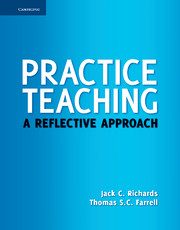Book contents
- Frontmatter
- Contents
- Introduction
- Chapter 1 Learning to Teach Through Practice Teaching
- Chapter 2 The Nature of Teacher Learning
- Chapter 3 Understanding the Teaching Context
- Chapter 4 Working With Your Cooperating Teacher
- Chapter 5 Planning Your Teaching
- Chapter 6 Teaching an Effective Language Lesson
- Chapter 7 Classroom Observation in Teaching Practice
- Chapter 8 Creating an Effective Classroom Learning Environment
- Chapter 9 Developing Learner-Centered Teaching
- Chapter 10 Classroom Discourse and Communication
- Chapter 11 Exploring Your Own Teaching
- Chapter 12 After Teaching Practice
- References
- Author Index
- Subject Index
Chapter 2 - The Nature of Teacher Learning
Published online by Cambridge University Press: 05 October 2012
- Frontmatter
- Contents
- Introduction
- Chapter 1 Learning to Teach Through Practice Teaching
- Chapter 2 The Nature of Teacher Learning
- Chapter 3 Understanding the Teaching Context
- Chapter 4 Working With Your Cooperating Teacher
- Chapter 5 Planning Your Teaching
- Chapter 6 Teaching an Effective Language Lesson
- Chapter 7 Classroom Observation in Teaching Practice
- Chapter 8 Creating an Effective Classroom Learning Environment
- Chapter 9 Developing Learner-Centered Teaching
- Chapter 10 Classroom Discourse and Communication
- Chapter 11 Exploring Your Own Teaching
- Chapter 12 After Teaching Practice
- References
- Author Index
- Subject Index
Summary
INTRODUCTION
Your teaching-practice course aims to provide an opportunity for you to develop or improve your teaching skills through experiences provided by microteaching, by teaching in a second language classroom, and through reflecting on your teaching experience in discussions with your supervisor, fellow student teachers, and your cooperating teacher. The most crucial experiences will be those provided when you do your practice teaching in a real classroom (Richards and Crookes 1988). The words “practice teaching,” however, may give a misleading impression of what we understand by “learning to teach,” or as we shall refer to it throughout this book, “teacher learning.” “Practice teaching” suggests that development as a language teacher primarily involves acquiring a set of specific teaching skills, and that these gradually develop and improve through practice. Whereas aspects of teaching can certainly be regarded as skilled performance as we saw in Chapter 1, this book is predicated around a broader and, we hope, more meaningful understanding of what competence and expertise in teaching consist of, and consequently what the goals of teacher learning are. In this chapter we will consider the nature of competence and expertise in language teaching and examine eight different dimensions of teacher learning that are involved. The account we present here will provide the rationale for the approach to practice teaching we present throughout this book.
Information
- Type
- Chapter
- Information
- Practice TeachingA Reflective Approach, pp. 15 - 30Publisher: Cambridge University PressPrint publication year: 2011
Accessibility standard: Unknown
Why this information is here
This section outlines the accessibility features of this content - including support for screen readers, full keyboard navigation and high-contrast display options. This may not be relevant for you.Accessibility Information
- 5
- Cited by
